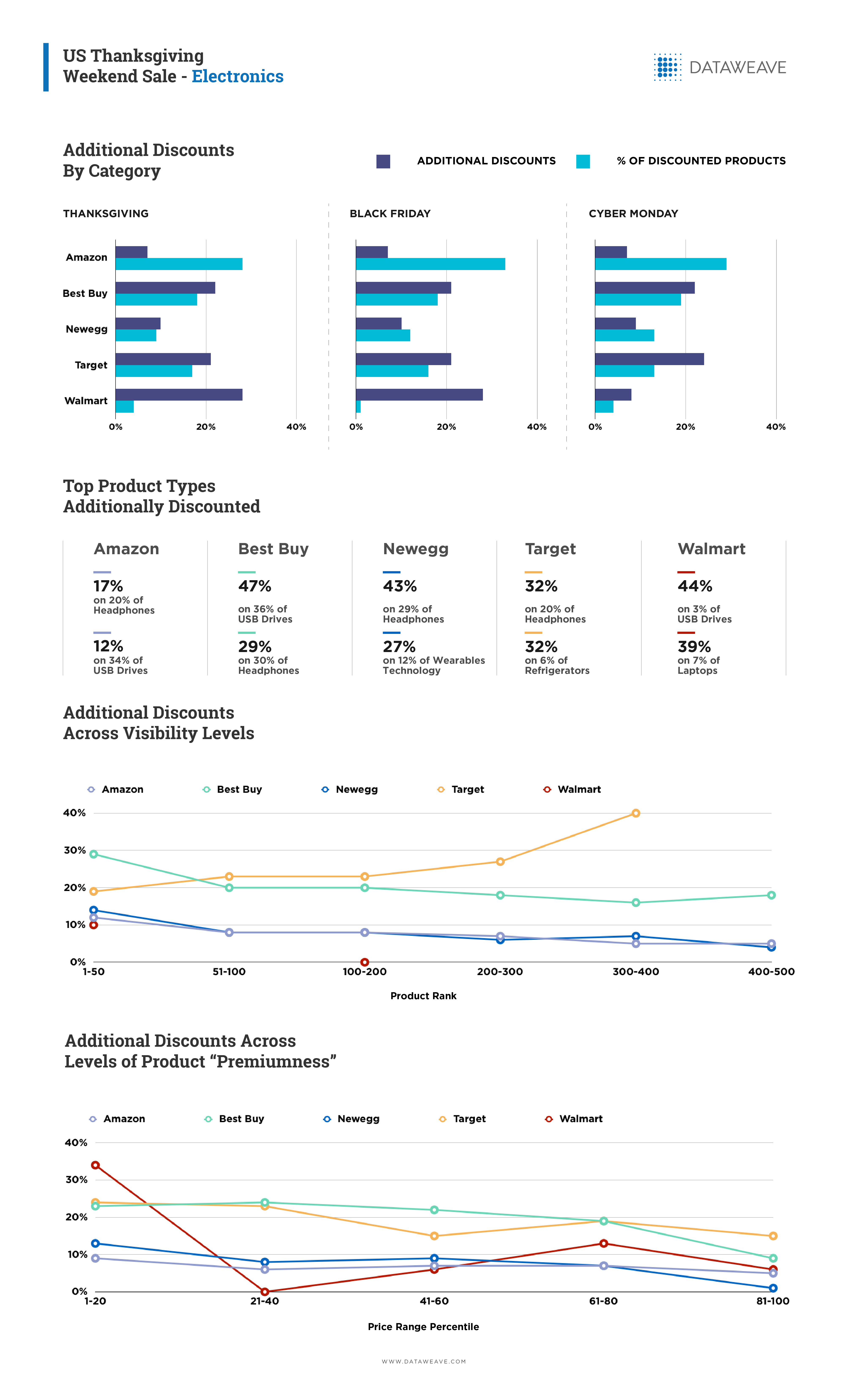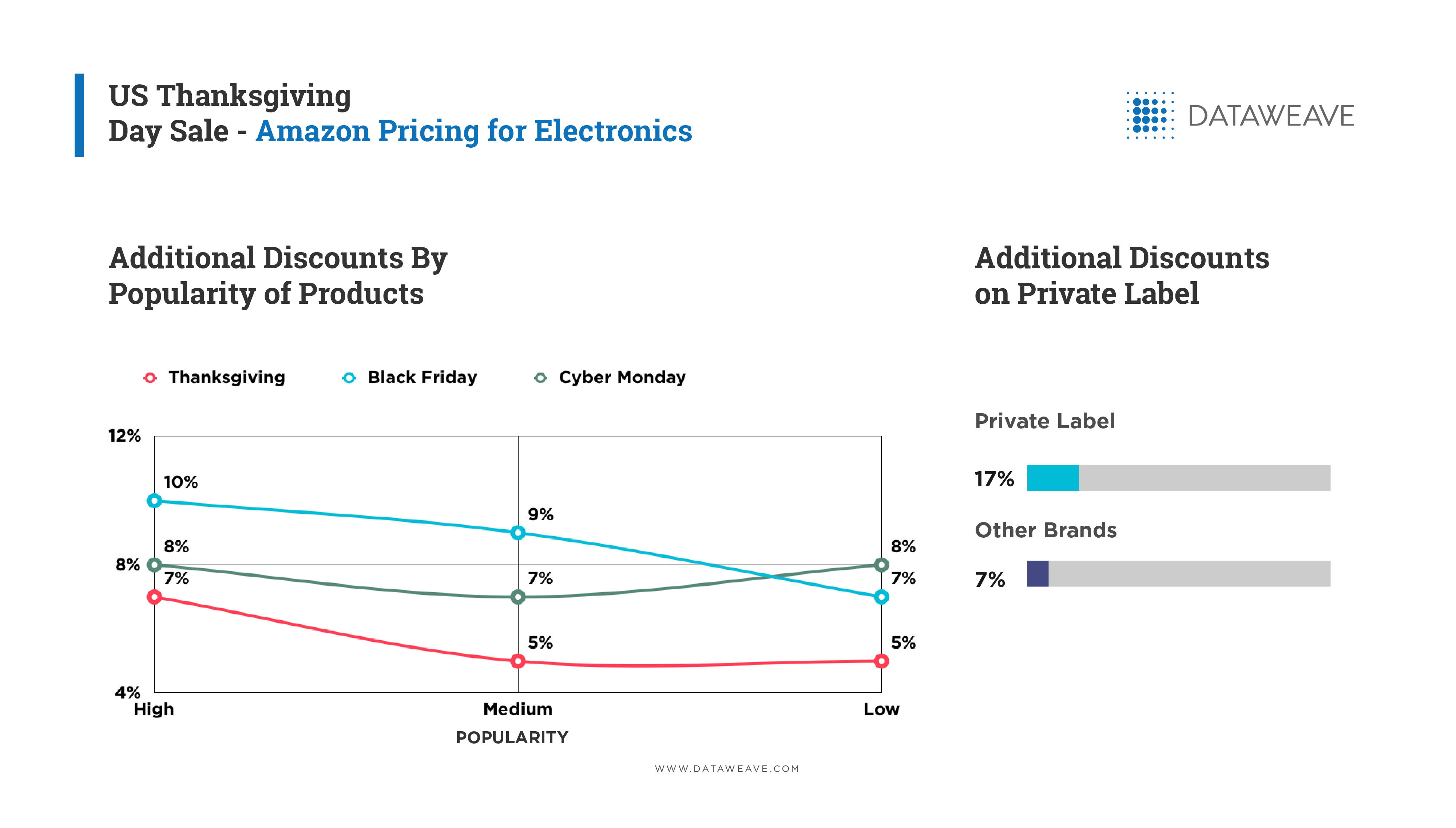Consumer electronics has always been one of the most popular product categories for consumers during the Thanksgiving weekend sale each year.
Shoppers often hold off on making expensive purchases in electronics in anticipation of great discounts during these sale events. While Cyber Monday is traditionally the key day for offers in electronics, recent trends, triggered by the growth of eCommerce, lean toward offering attractive prices across the entire sale weekend.
Studies indicate that in 2018, the average value of an online transaction hit $97. This compares with $91 in 2017 and $87 in 2016, continuing the trend of a steadily increasing transaction value over the past two years. This year, the scene was set for a massive Cyber Monday as Black Friday purchases of electronics reached $6.22 billion, up 23.6 percent from last year according to Adobe Analytics.
At DataWeave, we recently analyzed and published a blog post on the Thanksgiving weekend sale for the Fashion vertical.
(Read here: A Study of Fashion Retail Pricing Across Thanksgiving, Black Friday and Cyber Monday 2018)
As part of the same project, we scrutinized the consumer electronics vertical just as keenly across top electronics retailers in the US by monitoring prices across the weekend.
Our Methodology
We tracked the pricing of the 5 leading retailers selling consumer electronics to assess their pricing and product strategies during the sale events. Our analysis focused on additional discounts offered during the sale to evaluate the true value the sale event represented to customers. To calculate this effect, we compared the pricing of products on Thanksgiving Day, Black Friday and Cyber Monday to the pricing of products prior to the sale commencing. We considered the Top 500 ranked products on 11 popular product types in carrying out this analysis.
Key Findings

In contrast to the Fashion category, the consistency in the discounting strategy for all retailers across the three sale days in the Consumer Electronics category was striking. The only exception was Walmart, which opted somewhat curiously to roll back its discounts on Cyber Monday. All other retailers held similar additional discounts levels on a fairly similar set of products through the sale weekend.
Target and Best Buy led the electronics discount charge at 22% and 21% for 18% and 17% of their assortment, respectively.
While Amazon discounted the highest number of products at 29% of its range, it continued its recent strategy of not discounting steeply. In fact, Amazon was among the lowest in terms of additional discounts. The other end of the spectrum, Walmart provided a 28% additional discount on the first two sale days, offered only on a modest range of products (4% and 1%).
Headphones and USB Drives proved popular lead product types for discounting by all retailers. Other product types making the cut included Refrigerators (Target), Laptops (Walmart), and Wearable Technology (Newegg).
Amazon’s discounting strategy appears to be informed significantly by product visibility. The highest ranked products were far more aggressively discounted, and the discounts reduced progressively as we move to less visible products. This supports previous evidence illuminating Amazon’s strategy to develop a low price perception. We saw a similar trend emerging from Best Buy and Newegg as well.
This discounting approach is in stark contrast to the behavior we witnessed in our earlier analysis of the Fashion category, where we found little correlation between visibility and discounts. However, given the higher price points and greater price elasticity in the Electronics category, we were not surprised to see this level of strategic clarity. Interestingly, our analysis of Target’s discounting behavior showed an opposite trend as Target opted to load up discounts on its less visible products.
Walmart was excluded from this part of our study due to the very low number of common products before and during the sale that we could analyze.
Another stable trend which emerged during our analysis of the sale weekend is the consistency with which lower priced products are offered at higher additional discounts relative to the more premium, higher priced products in the retailers’ product type. This trend largely held across retailers. Customer perceptions of low prices can be built by heavily discounting products at the lower end of the premium spectrum, while retailers can harvest their critical margin on their higher value goods.
Diving Deeper Into Amazon

Amazon announced a few days ago that it had its biggest shopping day in the company’s history on Cyber Monday. In its announcement, the company also stated the five shopping days starting with Thanksgiving and continuing through to Cyber Monday shattered records as US consumers bought millions of more products over the five-day sales compared with the same sales period last year.
When the product popularity was evaluated and compared with additional discounts, we see higher discounts for better-reviewed products on Thanksgiving and Black Friday. Cyber Monday was an exception where discounts were distributed more smoothly across the three popularity bands.
As with what we witnessed in the Fashion category, we detected higher additional discounts in Amazon’s Electronics private label brands (17%) relative to the average discount for other brands (7%).
Profitability is back in the spotlight
Electronics continued to be a key focus eCommerce retailers during their pivotal sales events in 2018. We are seeing signs of a shift to eCommerce and an accelerating emergence of a “Black November” and a “Cyber Post-Thanksgiving Weekend” impacting on sales results for the beginning of the holiday season.
This year, there was a more concerted and strategic approach by retailers to maximize margin in the high-value end of the Electronics Category while still discounting the more popular and lower priced products. As expected, both Target and Best Buy featured prominently with their heavy discounting, while both Amazon and Newegg appeared to be executing a more nuanced discounting strategy. This rather reserved approach to the sale and careful focus on profitability is backed up by recent reports of Amazon’s shift in approach to housing low margin products.
As was the case with the Fashion category, we saw the importance of Cyber Monday for Electronics sales being eroded and spread across the entire weekend, on the backdrop of a larger trend of attractive offers encompassing much of November and December.
If you would like to know more about how DataWeave aggregates data from online sources to deliver actionable insights to retailers and consumer brands, check out our website!
